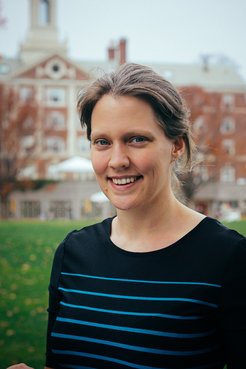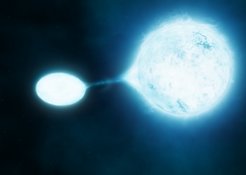Stars, stars, stars
Selma E. de Mink appointed as director at the Max Planck Institute for Astrophysics
As of 1 January 2021, Selma E. de Mink has started her new directorship at the Max Planck Institute for Astrophysics (MPA). She will head the stellar astrophysics department at the institute and will bolster research into the life, death and after-life of stars. De Mink is a Dutch national and still affiliated with University of Amsterdam in her home country. She is moving back to Europe from the US, where she held a professorship at Harvard University.

Stars are the main research interest for Selma de Mink. They are the nuclear factories producing all the heavy elements that we are made of, from carbon and oxygen to much heavier elements such as iron. They live an exciting life, interacting with their surroundings not only through radiation but also through winds, and often end their lives in spectacular explosions.
One speciality of Selma E. de Mink: binary stars, i.e. stars that are not alone but rather in a bound system. In the past decade, astrophysicists realised that all massive stars form binary systems, which led to a huge surge of interest. This was further strengthened by the first discoveries of merging black holes through gravitational waves, with massive binary stars as the most likely progenitors.
Depending on their mass, stars end their lives in more or less energetic explosions, leaving behind a compact remnant. While our Sun will end up as a white dwarf, more massive stars form neutron stars or even black holes – and in the case of massive binary stars also a binary black hole system. While this outcome is very rare, and catching a binary black hole system in the act of merging even more so, astrophysicists are excited about the new window that gravitational wave astronomy has opened into the universe.
While much harder to detect than electromagnetic radiation, gravitational waves are not hampered by dust – they pervade everything. With new gravitational wave detectors being planned and developed, we might be able to “hear” gravitational wave mergers throughout the entire history of the universe. To make accurate predictions for what they will be able to detect, astrophysicists need to understand the physics behind the formation of black hole binaries – and for this, they need to understand also all the other outcomes. And to understand the outcome, one first needs to understand the evolution that led to this end.

Therefore, the evolutionary pathways of stars, in particular the ones leading to the emission of gravitational waves, is a high priority for Selma de Mink in her research at MPA. With her group – for which she is currently recruiting – she will use computer simulations and observational surveys to study the details of stars in the prime of their life. Observations of transients, such as massive amounts of data from robotic surveys, will offer information on the death of stars. From these, her group will then be able to make predictions on the stars’ afterlife.
Selma de Mink studied physics and mathematics at Utrecht University and finished her PhD there with a thesis on “Stellar evolution at low metallicity” in 2010. Her postdoc positions led her to the University of Bonn, the Space Telescope Science Institute in Baltimore and the California Institute for Technology & Carnegie Observatories, Pasadena, before she became a professor at the University of Amsterdam in 2014 and at Harvard University in 2019.
Her work has been recognised with many prizes and distinctions, among them the Hubble and the Einstein fellowships by NASA in 2010 and 2013, an ERC starting grant in 2016, and the MERAC Prize in Theoretical Astrophysics 2017 by the European Astronomical Society. In 2019, she was elected as Member of the Young Scientific Academy in the Netherlands. She has published more than 100 refereed papers, which have been cited more than 8000 times.
Connecting theory to observations is a central interest for Selma de Mink and one for which Garching is well suited. It is one of the largest astronomy hubs in Europe, with experimentalists next door to theorists and many experts with diverse backgrounds. Stars relate to so many aspects in astronomy and physics that she expects a lot of interaction with the other groups and departments concentrated at the campus. She enjoys creating groups of critical mass and is looking forward to many stimulating discussions about the role of stars throughout cosmic history.













